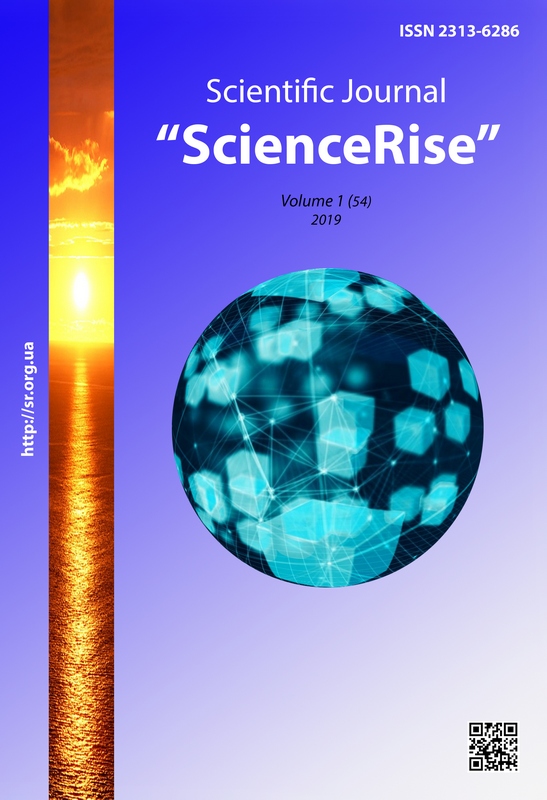Chemometric methods for research of biological activity of quinoline derivatives
DOI:
https://doi.org/10.15587/2313-8416.2019.155424Keywords:
"structure-activity", spectrum of biological activity, prediction, PASS, predictive ability, QSARAbstract
An important characteristic of chemical compounds is their biological activity, since its presence may be the basis for the use of the substance for therapeutic purposes, or, conversely, limit the possibilities of its practical application due to the occurrence of side and toxic effects. Computer evaluation of the spectrum of biological activity makes it possible to determine the most promising areas for testing the pharmacological effects of specific substances and weed out potentially dangerous molecules in the early stages of research. Description of the structure of molecules of organic compounds is implemented in PASS using descriptors of atomic neighborhoods (Multilevel Neighborhoods of Atoms)
References
Brazhko, O. A. (2005). Biological active derivatives of quinoline and acridine with nitrogen and sulfur-containing functional groups. Kyiv, 456.
Zavgorodniy, M. P., Brazhko, A. A., Veselkov, A. V. (2015). QuS: A Software for Automated QSAR analysis of Biologically Active Compounds. Chemistry of Nitrogen Containing Heterocycles-2015. Kharkiv: Ekskluziv Publ., 26.
Zefirov, N. S., Palyulin, V. A. (2002). Fragmental Approach in QSPR. Journal of Chemical Information and Computer Sciences, 42 (5), 1112–1122. doi: http://doi.org/10.1021/ci020010e
Martin, T. M. (2016). Toxicity Estimation Software Tool (TEST). Washington: U.S. Environmental Protection Agency. Available at: https://www.epa.gov/chemical-research/toxicity-estimation-software-tool-test
Lesk, A. (2009). Introduction to Bioinformatics. Moscow: BINOM. Lab knowledge, 318.
Golovenko, N. A. (2004). Physicochemical Pharmacology. Odessa: Astroprint, 720.
Tetko, I. V., Gasteiger, J., Todeschini, R., Mauri, A., Livingstone, D., Ertl, P. et. al. (2005). Virtual Computational Chemistry Laboratory – Design and Description. Journal of Computer-Aided Molecular Design, 19 (6), 453–463. doi: http://doi.org/10.1007/s10822-005-8694-y
Prajapati, K., Singh, S., Pathak, A. K., Mehta, P. (2011). QSAR analysis on some 8-methoxyquinoline derivatives as H37RV inhibitors. International Journal of ChemTech Research, 193, 408–422.
Abhinav, P. M. (2012). 2D-QSAR study of 2,5-dihydropyrazolo[4,3-c]quinoline-3-one a novel series of PDE-4-inhibitors. Journal of Pharmaceutical and Biomedical Sciences, 3 (1), 105.
Vainio, M. J., Johnson, M. S. (2005). McQSAR: A Multiconformational Quantitative Structure–Activity Relationship Engine Driven by Genetic Algorithms. Journal of Chemical Information and Modeling, 45 (6), 1953–1961. doi: http://doi.org/10.1021/ci0501847
Ruddigkeit, L., Blum, L. C., Reymond, J.-L. (2013). Visualization and Virtual Screening of the Chemical Universe Database GDB-17. Journal of Chemical Information and Modeling, 53 (1), 56–65. doi: http://doi.org/10.1021/ci300535x
Poroikov, V. V., Filimonov, D. A., Borodina, Y. V., Lagunin, A. A., Kos, A. (2000). Robustness of Biological Activity Spectra Predicting by Computer Program PASS for Noncongeneric Sets of Chemical Compounds. Journal of Chemical Information and Computer Sciences, 40 (6), 1349–1355. doi: http://doi.org/10.1021/ci000383k
Downloads
Published
Issue
Section
License
Copyright (c) 2019 Alexander Brazhko

This work is licensed under a Creative Commons Attribution 4.0 International License.
Our journal abides by the Creative Commons CC BY copyright rights and permissions for open access journals.
Authors, who are published in this journal, agree to the following conditions:
1. The authors reserve the right to authorship of the work and pass the first publication right of this work to the journal under the terms of a Creative Commons CC BY, which allows others to freely distribute the published research with the obligatory reference to the authors of the original work and the first publication of the work in this journal.
2. The authors have the right to conclude separate supplement agreements that relate to non-exclusive work distribution in the form in which it has been published by the journal (for example, to upload the work to the online storage of the journal or publish it as part of a monograph), provided that the reference to the first publication of the work in this journal is included.

